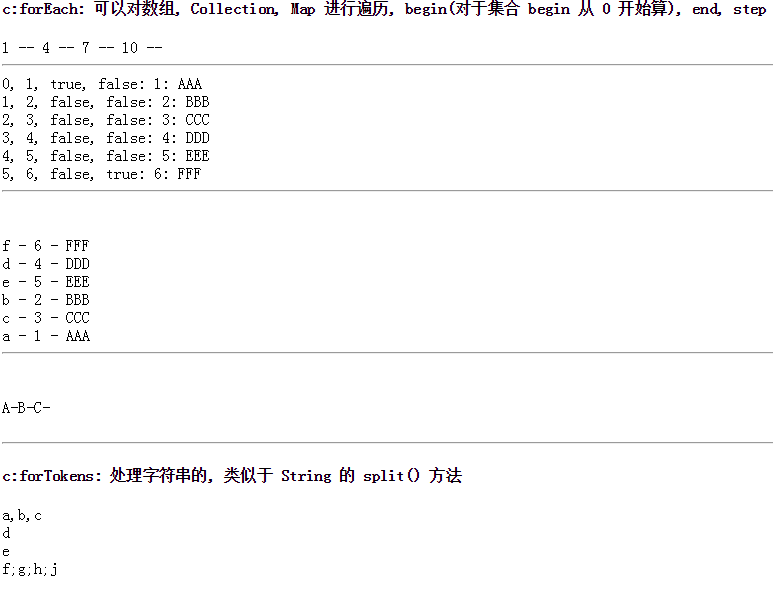jstl 标签使用
1)*. c:out 主要用于对特殊字符进行转换. 真正进行输出时, 建议使用 c:out, 而不是使用 EL
2)*. c:set: 可以为域赋属性值。 而对域对象中的 JavaBean 的属性赋值用的并不多.
3). c:remove: 移除指定域对象的指定属性值(较少使用, 即便移除也是在 Servlet 中完成)
4)*. c:if: 在页面上对现实的内容进行过滤, 把结果存储到域对象的属性中. 但不灵活, 会被其他的自定义标签所取代.
5). c:choose, c:when, c:otherwise: 作用同上, 但麻烦, 不灵活.
6)*. c:forEach: 对集合进行遍历的. 常用!
7). c:forTokens: 处理字符串, 类似于 String 累的 split() 方法(知道即可)
8). c:import: 导入页面到当前页面的. (了解)
9). c:redirect: 当前页面进行重定向的. (使用较少)
10)*. c:url: 产生一个 URL 的, 可以进行 URL 重写, 变量值编码, 较为常用.
使用jstl时首先先要导入相关的jar包
<%@ taglib prefix="c" uri="http://java.sun.com/jsp/jstl/core" %>c:forEach:
<%@ page language="java" import="java.util.*" pageEncoding="utf-8"%>
<%@ page import="com.atguigu.javaweb.Customer"%>
<%
String path = request.getContextPath();
String basePath = request.getScheme()+"://"+request.getServerName()+":"+request.getServerPort()+path+"/";
%>
<%@ taglib prefix="c" uri="http://java.sun.com/jsp/jstl/core" %>
<!DOCTYPE HTML PUBLIC "-//W3C//DTD HTML 4.01 Transitional//EN">
<html>
<head>
<base href="<%=basePath%>">
<title>My JSP 'foreach.jsp' starting page</title>
<meta http-equiv="pragma" content="no-cache">
<meta http-equiv="cache-control" content="no-cache">
<meta http-equiv="expires" content="0">
<meta http-equiv="keywords" content="keyword1,keyword2,keyword3">
<meta http-equiv="description" content="This is my page">
<!--
<link rel="stylesheet" type="text/css" href="styles.css">
-->
</head>
<body>
<h4>c:forEach: 可以对数组, Collection, Map 进行遍历, begin(对于集合 begin 从 0 开始算), end, step</h4>
<c:forEach begin="1" end="10" step="3" var="i">
${ i} --
</c:forEach>
<hr>
<%
List<Customer> custs = new ArrayList<Customer>();
custs.add(new Customer(1, "AAA")); //index: 0
custs.add(new Customer(2, "BBB")); //1
custs.add(new Customer(3, "CCC"));
custs.add(new Customer(4, "DDD")); //3
custs.add(new Customer(5, "EEE"));
custs.add(new Customer(6, "FFF")); //5
request.setAttribute("custs", custs);
%>
<!-- 遍历 Collection, 遍历数组同 Collection -->
<c:forEach items="${requestScope.custs }" var="cust"
varStatus="status">
${status.index}, ${status.count}, ${status.first}, ${status.last}: ${cust.id }: ${cust.name }<br>
</c:forEach>
<hr>
<!-- 遍历 Map -->
<%
Map<String, Customer> custMap = new HashMap<String, Customer>();
custMap.put("a", new Customer(1, "AAA")); //index: 0
custMap.put("b", new Customer(2, "BBB")); //index: 0
custMap.put("c", new Customer(3, "CCC")); //index: 0
custMap.put("d", new Customer(4, "DDD")); //index: 0
custMap.put("e", new Customer(5, "EEE")); //index: 0
custMap.put("f", new Customer(6, "FFF")); //index: 0
request.setAttribute("custMap", custMap);
%>
<br><br>
<c:forEach items="${requestScope.custMap }" var="cust">
${cust.key } - ${cust.value.id } - ${cust.value.name }<br>
</c:forEach>
<hr>
<%
String [] names = new String[]{"A", "B", "C"};
request.setAttribute("names", names);
%>
<br><br>
<c:forEach var="name" items="${names }">${name }-</c:forEach>
<br><br>
<c:forEach items="${pageContext.session.attributeNames }" var="attrName">
${attrName }-
</c:forEach>
<hr>
<h4>c:forTokens: 处理字符串的, 类似于 String 的 split() 方法</h4>
<c:set value="a,b,c.d.e.f;g;h;j" var="test" scope="request"></c:set>
<c:forTokens items="${requestScope.test }" delims="." var="s">
${s }<br>
</c:forTokens>
</body>
</html>
<h4>
c:choose, c:when, c:otherwise: 可以实现 if...else if...else if...else 的效果. 但较为麻烦
其中: c:choose 以 c:when, c:otherwise 的父标签出现.
c:when, c:otherwise 不能脱离 c:choose 单独使用.
c:otherwise 必须在 c:when 之后使用。
</h4>
<c:choose>
<c:when test="${param.age > 60 }">
老年
</c:when>
<c:when test="${param.age > 35 }">
中年
</c:when>
<c:when test="${param.age > 18 }">
青年
</c:when>
<c:otherwise>
未成年.
</c:otherwise>
</c:choose>
<c:set value="20" var="age" scope="request"></c:set>
<h4>c:if: 不能实现 else 操作, 但可以把结果储存起来。 </h4>
<c:if test="${requestScope.age > 18 }">成年了!</c:if>
<br><br>
<c:if test="${param.age > 18 }" var="isAdult" scope="request"></c:if>
isAdult: <c:out value="${requestScope.isAdult }"></c:out>
<h4>c:remove: 移除指定域对象的指定属性值</h4>
<c:set value="1997-09-1" var="date" scope="session"></c:set>
date: ${sessionScope.date }
<br><br>
<c:remove var="date" scope="session"/>
date: --${sessionScope.date }--
<br><br>
<h4>c:set: 可以为域赋属性值, 其中 value 属性支持 EL 表达式; 还可以为域对象中的 JavaBean 的属性赋值, target, value都支持 EL 表达式</h4>
<c:set var="name" value="ATGUIGU" scope="page"></c:set>
<%--
pageContext.setAttribute("name", "atguigu");
--%>
name: ${pageScope.name }
<br><br>
<c:set var="subject" value="${param.subject }" scope="session"></c:set>
subject: ${sessionScope.subject }
<br><br>
<%
Customer cust = new Customer();
cust.setId(1001);
request.setAttribute("cust", cust);
%>
ID: ${requestScope.cust.id }
<c:set target="${requestScope.cust }" property="id" value="${param.id }"></c:set>
<br>
ID: ${requestScope.cust.id }
<br><br>
<h4>c:out: 可以对特殊字符进行转换. </h4>
<%
request.setAttribute("book", "<<Java>>");
%>
book: ${requestScope.book }
<br><br>
book: <c:out value="${requestScope.book }" default="booktitle"></c:out>






















 3187
3187











 被折叠的 条评论
为什么被折叠?
被折叠的 条评论
为什么被折叠?








